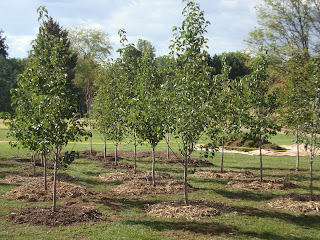We horties gossip as much as any other office clique...generally about bad gardening advice. Usually I just roll my eyes at the stuff (something I perfected as a teenager), but this time…it struck a nerve. Maybe it’s because I’m a huge advocate of that shredded wood we call "mulch", but I felt the need to blog about it. Whether you agree with me or not…
Fellow blogger, Tony Koski, emailed this link to me and a few colleagues last week, from a blog, called “Grounded Design”. The author, Thomas Rainer, does have some valid points. But I just can’t get on board with his philosophy about hating tree mulch rings? If you choose not to read the article, Mr. Rainer suggests the following about mulch rings at the base of trees:
--They are “ugly” and “have got to go” and “make Swiss cheese out of a continuous lawn”
--They don’t make mowing easier; he states that it’s not difficult to mow around trees, and mulch rings actually require more maintenance [compared to turf]
--Rather than mulching, he suggests planting continuous vegetation to the base of the tree
I do agree with Mr. Rainer on a couple counts. First, improper mulching is very bad for the tree. Volcano mulching and covering the flare does lead to stem girdling roots, creates a textural interface that can reduce oxygen availability to the tree’s roots and disrupt water movement to the root ball. Second, he admits that it does keep mowing equipment and string trimmers away from the base of the tree—one of the main reasons I advocate for mulch. How many of you have seen trees nicked or wounded from equipment? It’s tough on the tree (and often leads to decline or death), and it looks horrible. I’d gladly pick the “Swiss cheese” look over gaping trunk wounds any day.
 |
| If that doesn't make you wince! Ouch. |
 |
| Clearly the tree "guard" failed. Mulch may have prevented this from happening. |
My mother-in-law says it best: mulch is like make-up for the landscape—it looks good and has many benefits…if applied correctly. In most of our urban areas, water restrictions begin today. It’s been proven than mulch can reduce water evaporation from the soil surface by up to 70%. That’s significant. In addition, a study conducted at the College of DuPage in Illinois by Morton Arboretum staff found that trees that were mulched had significantly greater caliper, crown and root development compared to those with turf growing up to their base (Green and Watson, 1989). Another study found that mulch modified the soil environment, increased root and shoot growth and aided in plant establishment of desert willow, while turf impaired its establishment (Kraus, 1998).
 |
| Trees with mulch rings...does it really look that bad? Is it better to sacrifice tree health at the expense of design? Trees struggle enough in our tough Colorado climate. |